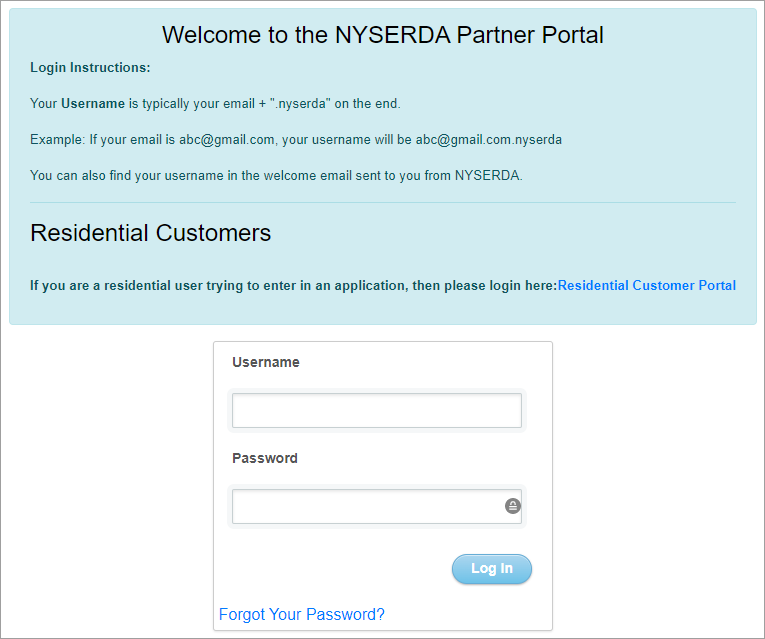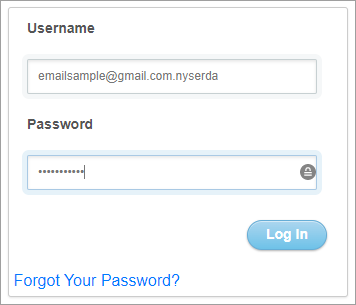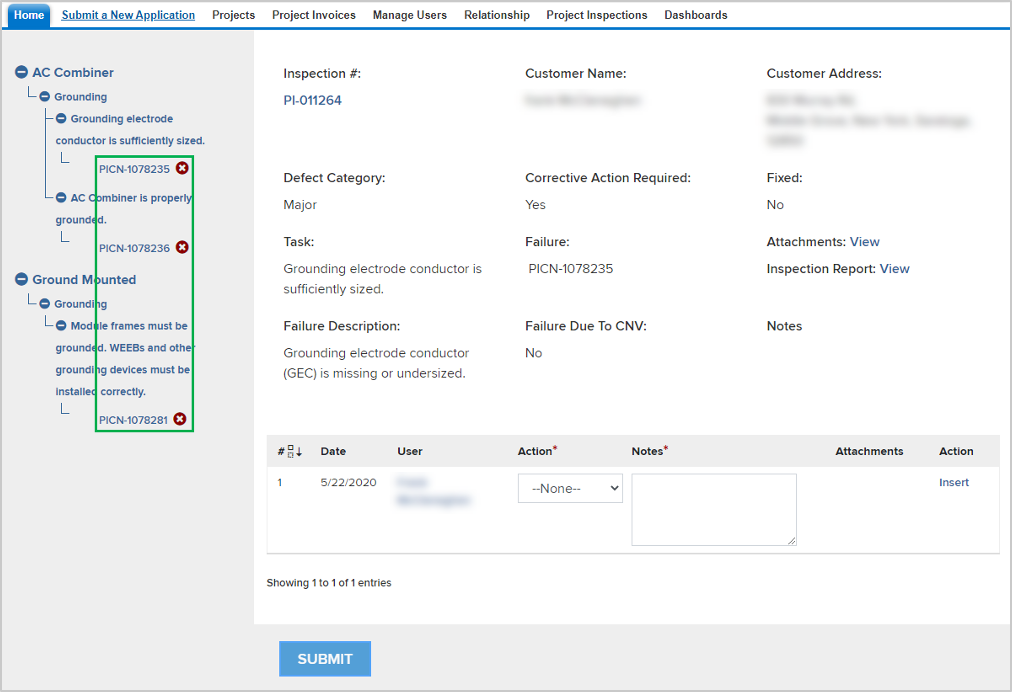The diagram below outlines the SQA Process Steps for the complete inspection process. The standard inspection process is outlined in the All Inspections row. If an inspection requires Corrective Actions, this process is included in the Correct Action Required Path. Generally speaking, Inspections without major or critical non-conformances will typically end at the Review & Approve Inspection step in the All Inspections row. If there are any CAR Tasks, the process will include the Corrective Action Required Path. |
|
NYSERDA conducts a minimum of three field inspections for each new participating Contractor. New contractors who have not passed three inspections are listed as Provisional. When they are in good standing after these inspections, their status is updated to Full. After an installer receives Full status, NYSERDA reviews a random sample of projects for review. Contractors with a Probationary or Suspended status may have 100% of their projects inspected. |
|
Once an inspection has been completed and submitted by the Inspector, and is reviewed and approved by the QSP QA Manager, an Inspection Report is generated and appended to the Project Inspection Record. An email is systematically sent to the Contractor with a link to the Inspection Report. Below are examples of the heading for an Inspection Report for both a passed and failed inspection. In an actual Inspection Report, below the Pass/Fail heading displays details on all aspects of the inspection results. |
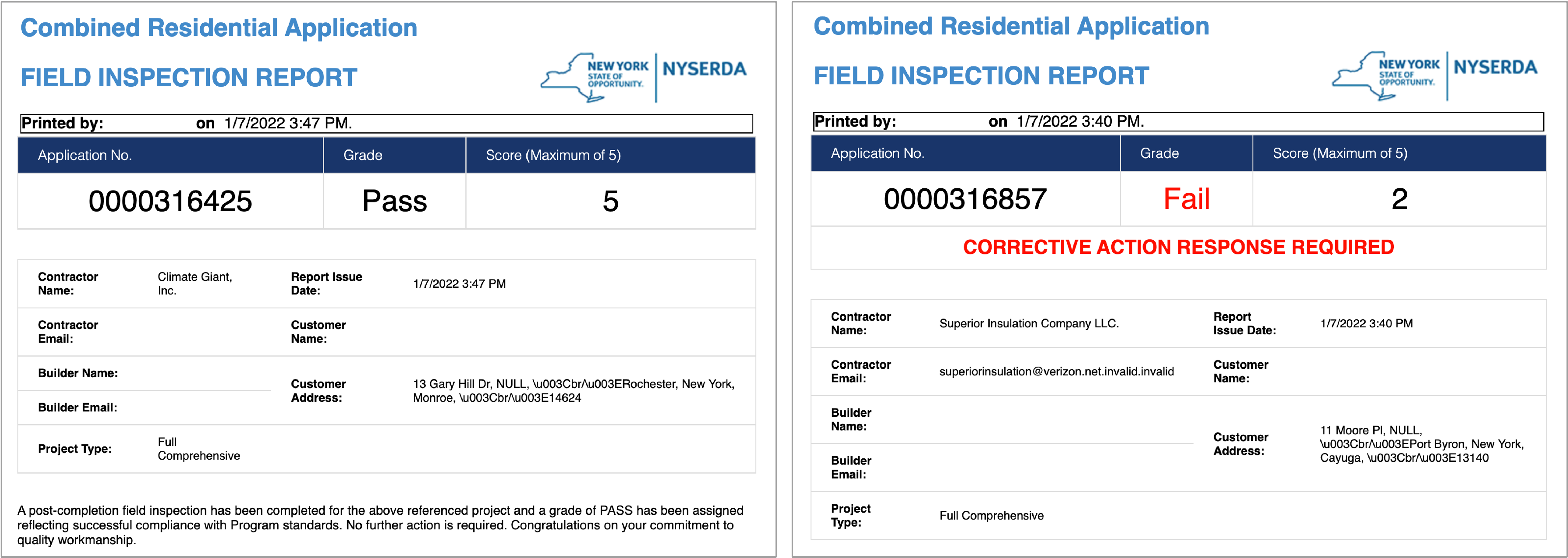
|
|
Contractors receive email communication about SQA inspections. When an Inspector schedules a project for SQA, an email will be sent to the contractor with the inspection date, time, and address. NYSERDA automatically sends emails for cancelled and rescheduled inspections. The QSP QA Manager - the designated manager from the QSP QA agency - approves and distributes inspection reports to the project applicant. In rare instances a Contractor may not be notified of an upcoming inspection upon the customer’s request. |
|
The SQA Salesforce module assigns a Quality Score (on a scale of 1 to 5) based on the inspection results. This score will be provided in the Inspection report that is generated after the Inspector completes the inspection. NYSERDA provides Contractors a link to the inspection report through Salesforce. | SQA Quality Score | Quality Score Description |
|---|
| 1 or 2 | Signifies a Failed Inspection with major and/or critical non-conformances. The Contractor must provide evidence to NYSERDA that these non-conformances outlined in the Inspection Report were resolved. Inspections in this score range may also contain minor or incidental non-conformances that will still need resolution, though the Contractor is not required to provide evidence for these issues. The inspection score may be updated if the Major and/or critical non-conformances are successfully contested | | 3, 4, or 5 | Signifies a Passed Inspection with only minor or incidental non-conformances. The Contractor must correct these issues but is not required to provide evidence to NYSERDA. |
|
|
|
The Standards and Quality Assurance (SQA) module is built within the NYSERDA Partner Portal (Salesforce). All activity related to scheduling, conducting, reviewing and approving inspections, and managing corrective action responses and resolutions, is documented and managed from within Salesforce. |
Access the portal login page at  . .
|
Enter your Username and Password and click Log In. Your username is your email address through your organization with .nyserda added to the end as shown in the example screenshot below. You created the password when accessing the NYSERDA Partner Portal the first time after receiving login information from NYSERDA. If you have forgotten the password, click the Forgot Your Password? Link and follow the prompts to reset your password.
|
|
|
|
The Dashboard page provides an overview of your projects and to the available reports for Contractors/Builders. |
After logging into Salesforce, click the Dashboards tab to access the Dashboard. |
The Dashboard includes several visual charts to help you track your projects. 
| A | If you have access to several dashboards, use the dropdown menu to navigate between them | | B | Click Refresh to update the dashboards and display the most up-to-date information | | C | Hover your mouse over any data elements in any graph to reveal a tooltip with granular details | | D | Each chart in the Dashboard has an underlying report that can be accessed by clicking the chart |
|
|
|
|
|
To access all of the reports available to Contractors/Builders, follow the instructions below. |
After logging into Salesforce, access the Dashboards tab. |
Then click the Go to Dashboard List link. |
Select the Program folder to access the report list. Once clicked, the reports will show to the right. |
Below is a list of all reports available to Contractors/Builders. | Report Name | Description |
|---|
| Contractor Inspection Dashboard | High-level overview of completed inspections. | | Photo Inspection Score | Overview of all photo inspection score over a set period of time. | | 2018 Inspection Scores* | List of all projects from 2018. | | 2019 Inspection Scores* | List of all projects from 2019. | | Invoices by Payment Status** | Groups projects by invoice status and displays invoice amount. | | Status and System Size* | Groups projects by project status and system size. | | Waiting and Response* | Lists all projects that require input/response for process participants. | | Number of Projects by Utility* | Groups projects by electric utility company. | | Open Projects with Completion Deadline* | Lists all approved projects at risk for termination. | | Inspection List | Lists all approved/completed field or photo inspection projects. |
| * Includes links to Project records
** Includes links to Project and Invoice records
*** Includes links to Project and Inspection records
|
|
After accessing a report, use the Filters at the top of the page to define how the information in the report should be displayed. 
| Run Report | Click to update the report information based on the filters set. | | Hide Details | Hides the details of each heading in the report table. Click again to unhide these details. | | Printable View | Click to open the report in a print friendly format. | | Export Details | Exports the report into an excel format. |
|
|
Click any Underlined Link in a report table to open the corresponding Project Record.
|
|
|
|
|
Corrective Action Required (CAR) tasks may be assigned to specific Measures or Tasks for an inspection. CARs, in general, highlight major or critical deficiencies of the installation or project. Contractors/Builders who receive CAR tasks related to a prior inspection must resolve all Critical and Major failed tasks. This may require performing additional work on the build site to fix any documented issues. Once these issues have been resolved, Contractors/Builders should follow the following process to update the inspection record. |
Contractors and Builders respond to Corrective Action Required (CAR) tasks through the Review Failed Tasks page in Salesforce. Access to this page can be found in the email communication sent to Contractors and Builders when an inspection uncovers CARs.
|
On the Review Failed Tasks page, use the side navigation bar to locate all CAR eligible failed tasks. Major or Critical failed tasks that require a response are denoted with a Red X to the right of the task. The first failed task will already be visible.
|
For each CAR eligible failed task, click the Action dropdown list and select Mark as Resolved, then add a note in the Notes section. Finally, click Insert to update the failed task and open the attachment window. 
Note that an Action must be selected, and Notes documented before you are able to click the Insert option to upload new files or photos. Additionally, the Mark as Resolved option is only available for Major or Critical failed tasks. Given that Minor or Incidental failed tasks do not require a response to NYSERDA if resolved, that option is not available. |
|
|
In the Attachment column, click the Paperclip icon to open the CAR Failure Review Attachment window.
|
Click Choose Files in the new window to locate the files on your computer. Choose the appropriate file(s) for upload. 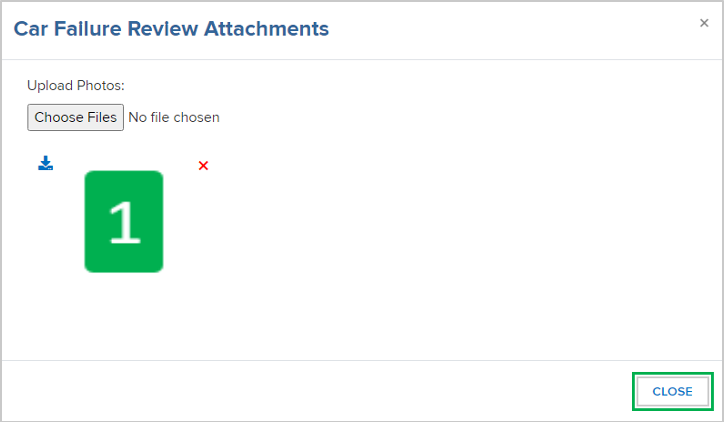
Multiple files or photos can be uploaded at the same time. Simply select multiple files or photos during Step three of this section. |
|
|
After a file is uploaded, a thumbnail of the file will display in the Attachment window. Click the Close button when complete. |
After successfully responding to all Failed tasks, click Submit at the bottom of the page to submit your CAR replies for review. |
After resolving the CAR tasks, the Program Implementer will review the submitted resolution. If the resolution is approved, no further actions are necessary for that specific CAR tasks. If the resolution is denied, the Program Implemented will reach out to request additional corrections. |
Complete the above steps for all other CAR tasks. |
|
|
|
To contest a failed task, follow step 1 and step 2 from the Resolving Corrective Actions (CARs) section on this page, then: |
To contest a failed task, select Contest Rating from the Action dropdown list. |
Follow all additional steps from the Resolving Corrective Actions (CARs) section until all CARs have been resolved or contested. - Contractors are still required to resolve any failed tasks if the Program Manager denies the contest.
- If the Program Implementer marks a Contest Failed Task as upheld, it will be escalated to the NYSERDA QA Manager.
|
Contested Failed Tasks that are upheld by the Program Implemented are escalated to the NYSERDA QA Manager who will also perform a review and either deny or uphold the contested failed task. - Contractors are still required to resolve any failed tasks if the NYSERDA QA Manager denies the contest.
- Contractors will receive a follow-up notification email regarding the CAR tasks and must respond by the Respond By date in the notification.
- Failed tasks can only be contested twice.
|
|
|
|
|
The video below is a recording of the training session provided to Participating Contractors on January 26, 2022. Click the Play button on the video to being watching the recording. You can also click the full window icon in the lower-right hand corner to open the video in full-screen mode.
|
The below presentation was used during the live training session to Participating Contractors. To read through the presentation, click once to open in full-screen mode, then scroll down to review additional slides. Do not use the arrows to the right and left after opening the presentation in full-screen mode as it will navigate to other attachments on this page.
|
|
|

